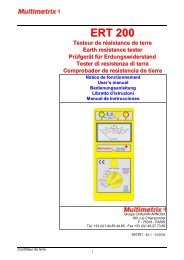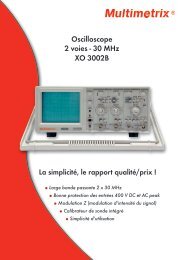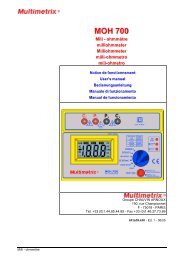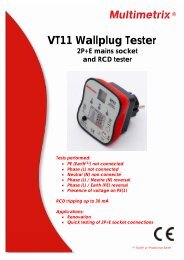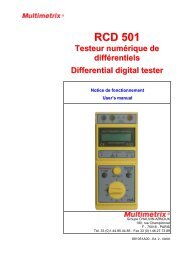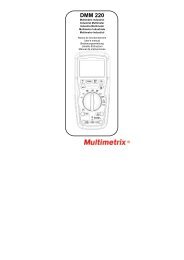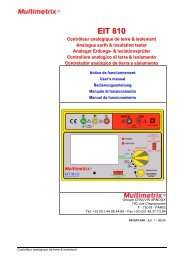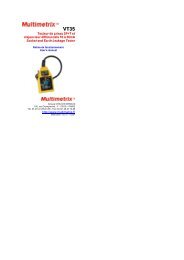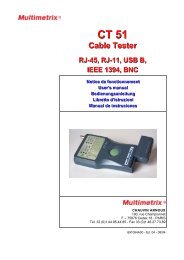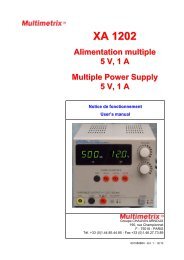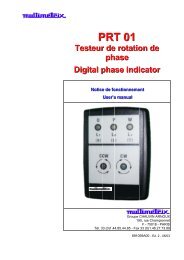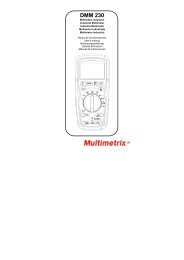Notice de fonctionnement - Multimetrix
Notice de fonctionnement - Multimetrix
Notice de fonctionnement - Multimetrix
Create successful ePaper yourself
Turn your PDF publications into a flip-book with our unique Google optimized e-Paper software.
XA 1202<br />
Alimentation multiple<br />
5 V, 1 A<br />
Multiple Power Supply<br />
5 V, 1 A<br />
Nottiice <strong>de</strong> ffoncttiionnementt<br />
Userr’’s manuall<br />
Groupe CHAUVIN ARNOUX<br />
190, rue Championnet<br />
F - 75018 - PARIS<br />
Tél. +33 (0)1.44.85.44.85 - Fax +33 (0)1.46.27.73.89<br />
691088B00 - Ed. 1 - 12/10
Français<br />
Instructions générales<br />
Introduction<br />
Vous venez d'acquérir une alimentation multiple ; cet appareil<br />
appartient à la gamme MULTIMETRIX. Nous vous remercions <strong>de</strong> votre<br />
confiance.<br />
Il est conforme à la norme <strong>de</strong> sécurité EN 61010-1, 2001, relative aux<br />
instruments <strong>de</strong> mesures électroniques. Vous <strong>de</strong>vez respecter, pour<br />
votre propre sécurité et celle <strong>de</strong> l'appareil, les consignes décrites dans<br />
cette notice, dont le contenu ne peut être reproduit sous quelque forme<br />
que ce soit sans notre accord.<br />
Sécurité Cette alimentation respecte la norme <strong>de</strong> sécurité EN 61010-1, classe 1,<br />
<strong>de</strong>gré <strong>de</strong> pollution 2. Elle a été conçue pour une utilisation en intérieur,<br />
en altitu<strong>de</strong> inférieure à 2000 m, à une température comprise entre 0°C<br />
et 50°C avec une humidité relative < 80 % jusqu’à 4 0°C.<br />
Sorties alimentation<br />
Catégorie <strong>de</strong> surtension<br />
Tension maximale <strong>de</strong> sortie<br />
50 V CAT I par rapport à la terre<br />
15 VDC<br />
Alimentation secteur<br />
Catégorie <strong>de</strong> surtension<br />
Tension d’alimentation<br />
Consommation<br />
300 V CAT II<br />
110 V ou 230 V ± 10 %; 50-60 Hz<br />
< 100 VA<br />
Définition <strong>de</strong>s<br />
catégories<br />
d’installation<br />
(cf. CEI 664-1)<br />
CAT I :<br />
Les circuits <strong>de</strong> CAT I sont <strong>de</strong>s circuits protégés par <strong>de</strong>s<br />
dispositifs limitant les surtensions transitoires à un faible<br />
niveau.<br />
Exemple : circuits électroniques protégés<br />
CAT II : Les circuits <strong>de</strong> CAT II sont <strong>de</strong>s circuits d'alimentation<br />
d'appareils domestiques ou analogues, pouvant comporter<br />
<strong>de</strong>s surtensions transitoires <strong>de</strong> valeur moyenne.<br />
Exemple : alimentation d'appareils ménagers et d'outillage<br />
portable<br />
CAT III : Les circuits <strong>de</strong> CAT III sont <strong>de</strong>s circuits d'alimentation<br />
d'appareils <strong>de</strong> puissance pouvant comporter <strong>de</strong>s surtensions<br />
transitoires importantes.<br />
Exemple : alimentation <strong>de</strong> machines ou appareils industriels<br />
CAT IV : Les circuits <strong>de</strong> CAT IV sont <strong>de</strong>s circuits pouvant comporter<br />
<strong>de</strong>s surtensions transitoires très importantes.<br />
Exemple : arrivées d'énergie<br />
Précautions<br />
Avant l’utilisation<br />
L'utilisation <strong>de</strong> cette alimentation implique <strong>de</strong> la part <strong>de</strong> l'utilisateur, le<br />
respect <strong>de</strong>s règles <strong>de</strong> sécurité habituelles permettant :<br />
- <strong>de</strong> se protéger contre les dangers du courant électrique,<br />
- <strong>de</strong> préserver l’alimentation contre toute fausse manœuvre.<br />
Pour votre sécurité, n'utilisez que le cordon livré avec l'appareil. Avant<br />
chaque utilisation, veillez à ce qu'il soit en parfait état. Il doit être<br />
branché sur le réseau avant <strong>de</strong> connecter les sorties.<br />
2
Français<br />
Instructions générales (suite)<br />
∗<br />
∗<br />
∗<br />
Toute interruption du conducteur <strong>de</strong> protection, à l’intérieur ou à<br />
l’extérieur <strong>de</strong> l’instrument, ou débranchement <strong>de</strong> la borne <strong>de</strong> terre<br />
<strong>de</strong> protection, risque <strong>de</strong> rendre l’instrument dangereux.<br />
L’interruption intentionnelle est interdite.<br />
Lorsque cet instrument doit être alimenté par l’intermédiaire d’un<br />
autotransformateur extérieur en vue d’une réduction <strong>de</strong> la tension,<br />
s’assurer que la borne commune est raccordée au neutre (pôle mis<br />
à la terre) du circuit d’alimentation.<br />
La fiche ne doit être introduite que dans une prise munie d’une<br />
pièce <strong>de</strong> contact <strong>de</strong> mise à la terre. La connexion <strong>de</strong> sécurité ne<br />
doit pas être interrompue par l’utilisation d’une rallonge sans<br />
conducteur <strong>de</strong> protection.<br />
Pendant l’utilisation ∗ Lorsque l’ordre <strong>de</strong> gran<strong>de</strong>ur <strong>de</strong>s paramètres tension et courant<br />
souhaités n’est pas connu, commencez par utiliser les valeurs<br />
les plus faibles.<br />
∗<br />
∗<br />
∗<br />
Avant <strong>de</strong> débrancher les cordons <strong>de</strong> liaison du circuit en essai,<br />
assurez-vous que l’alimentation est hors tension. Cela évite <strong>de</strong><br />
créer <strong>de</strong>s extra-courants <strong>de</strong> rupture ou <strong>de</strong> fermeture qui, pour<br />
<strong>de</strong> fortes intensités, risquent <strong>de</strong> faire fondre inutilement le<br />
fusible.<br />
Ne dépassez jamais une tension totale <strong>de</strong> sortie <strong>de</strong> plus <strong>de</strong><br />
50 V crête par rapport à la terre (mo<strong>de</strong> commun).<br />
L’appareil doit être installé dans un endroit ventilé. Veillez à ne<br />
pas obstruer les trous d’aération.<br />
Symboles sur<br />
l’instrument<br />
Attention : Référez-vous à la notice. Une utilisation incorrecte<br />
peut endommager l’appareil et mettre en jeu votre sécurité.<br />
Consignes<br />
Terre <strong>de</strong> protection<br />
Surface chau<strong>de</strong><br />
∗ Avant toute ouverture <strong>de</strong> l'appareil, déconnectez-le impérativement<br />
<strong>de</strong> toute source <strong>de</strong> courant électrique et <strong>de</strong>s circuits <strong>de</strong> mesure et<br />
assurez-vous <strong>de</strong> ne pas être chargé d'électricité statique, ce qui<br />
pourrait entraîner la <strong>de</strong>struction d'éléments internes.<br />
∗ Le fusible doit être remplacé par un modèle i<strong>de</strong>ntique à celui<br />
d’origine. Il se situe dans un porte fusible, à l’arrière <strong>de</strong> l’appareil.<br />
∗ Lorsque l'appareil est ouvert, certains con<strong>de</strong>nsateurs internes<br />
peuvent conserver un potentiel dangereux même après avoir<br />
mis l'appareil hors tension.<br />
∗ En cas <strong>de</strong> défauts ou contraintes anormales, mettez l'appareil<br />
hors service et empêchez son utilisation jusqu'à ce qu'il soit<br />
procédé à sa vérification.<br />
∗ Tout réglage, entretien ou réparation <strong>de</strong> l’instrument ne doit être<br />
effectué que par un personnel qualifié.<br />
∗ Une « personne qualifiée » est une personne familière avec<br />
l'installation, la construction, l'utilisation et les dangers présentés.<br />
Elle est autorisée à mettre en service et hors service l'installation<br />
et les équipements, conformément aux règles <strong>de</strong> sécurité.<br />
3
Français<br />
Instructions générales (suite)<br />
∗ Une « personne qualifiée » est une personne familière avec<br />
l'installation, la construction, l'utilisation et les dangers présentés.<br />
Elle est autorisée à mettre en service et hors service l'installation et<br />
les équipements, conformément aux règles <strong>de</strong> sécurité.<br />
Dispositif <strong>de</strong><br />
sécurité<br />
Garantie<br />
Vérification<br />
métrologique<br />
Entretien<br />
Réparations<br />
Déballage et<br />
ré-emballage<br />
Le fusible protège le primaire du transformateur d’alimentation contre<br />
les erreurs <strong>de</strong> tension réseau.<br />
Utiliser uniquement un fusible <strong>de</strong> type : T 4 A / 250 V.<br />
Ce matériel est garanti contre tout défaut <strong>de</strong> matière ou vice <strong>de</strong><br />
fabrication, conformément aux conditions générales <strong>de</strong> vente.<br />
Durant la pério<strong>de</strong> <strong>de</strong> garantie, l'appareil ne peut être réparé que par le<br />
constructeur, celui-ci se réservant la décision <strong>de</strong> procé<strong>de</strong>r soit à la<br />
réparation, soit à l'échange <strong>de</strong> tout ou partie <strong>de</strong> l'appareil. En cas <strong>de</strong><br />
retour du matériel au constructeur, le transport aller est à la charge du<br />
client. La garantie ne s’applique pas suite à :<br />
1. une utilisation impropre du matériel ou par association <strong>de</strong> celui- ci<br />
avec un équipement incompatible<br />
2. une modification du matériel sans autorisation explicite <strong>de</strong>s services<br />
techniques du constructeur<br />
3. l’intervention effectuée par une personne non agréée par le<br />
constructeur<br />
4. l'adaptation à une application particulière, non prévue par la<br />
définition du matériel ou par la notice <strong>de</strong> <strong>fonctionnement</strong><br />
5. un choc, une chute ou une inondation.<br />
Comme tous les appareils <strong>de</strong> mesure ou d'essais, une vérification<br />
périodique est nécessaire.<br />
Renseignements et coordonnées sur <strong>de</strong>man<strong>de</strong> :<br />
Tél. 02.31.64.51.55 - Fax 02.31.64.51.09.<br />
Débranchez l’instrument, puis nettoyez-le avec un chiffon légèrement<br />
imbibé d’eau savonneuse ; laissez sécher avant utilisation.<br />
N'utilisez jamais <strong>de</strong> produits abrasifs, ni <strong>de</strong> solvants.<br />
Pour les réparations sous garantie et hors garantie, contactez votre<br />
agence commerciale Chauvin Arnoux la plus proche ou votre centre<br />
technique régional Manumesure qui établira un dossier <strong>de</strong> retour et<br />
vous communiquera la procédure à suivre.<br />
Coordonnées disponibles sur notre site : http://www.chauvin-arnoux.com<br />
ou par téléphone aux numéros suivants : 02 31 64 51 55 (centre<br />
technique Manumesure), 01 44 85 44 85 (Chauvin Arnoux).<br />
L’ensemble du matériel a été vérifié mécaniquement et<br />
électriquement avant l’expédition.<br />
Toutefois, il est conseillé <strong>de</strong> procé<strong>de</strong>r à une vérification rapi<strong>de</strong> pour<br />
détecter toute détérioration éventuelle lors du transport. Si tel était le<br />
cas, faites alors immédiatement les réserves d’usage auprès du<br />
transporteur.<br />
En cas <strong>de</strong> réexpédition, utilisez l’emballage d’origine et indiquez, par<br />
une note jointe à l’appareil, les motifs du renvoi.<br />
4
Français<br />
Description <strong>de</strong> l’appareil<br />
Présentation<br />
Face avant<br />
Cette alimentation à sorties multiples <strong>de</strong> précision est conçue pour<br />
répondre aux besoins <strong>de</strong> l’enseignement, <strong>de</strong>s laboratoires et <strong>de</strong>s<br />
services <strong>de</strong> maintenance.<br />
10<br />
4<br />
9<br />
8<br />
5 6<br />
7<br />
Organes <strong>de</strong> comman<strong>de</strong><br />
1. Affichage digital du courant et <strong>de</strong> la tension en sortie<br />
2. LED Indicateur <strong>de</strong> régulation pour un courant constant (CC)<br />
3. LED Indicateur <strong>de</strong> régulation pour une tension constante (CV)<br />
4. Potentiomètre <strong>de</strong> réglage du courant<br />
5. Borne <strong>de</strong> terre fonctionnelle<br />
6. Borne <strong>de</strong> sortie négative (-)<br />
7. Borne <strong>de</strong> sortie positive (+)<br />
8. Interrupteur MARCHE/ARRET<br />
9. Potentiomètre <strong>de</strong> réglage tension « gros »<br />
10. Potentiomètre <strong>de</strong> réglage tension « fin »<br />
5
Français<br />
Description Fonctionnelle<br />
Sortie 12 V variable<br />
Réglage <strong>de</strong> la tension<br />
et du courant<br />
Utilisation en source<br />
<strong>de</strong> courant constant<br />
Utilisation en source<br />
<strong>de</strong> tension constante<br />
LCD 3 digits (résolution<br />
2 ½ digits)<br />
Attention<br />
• Connectez la charge souhaitée sur la sortie variable.<br />
• Sélectionner la polarité <strong>de</strong> la sortie avec le poussoir (11).<br />
• Mettez l’alimentation sous tension.<br />
• La tension et le courant s’affichent.<br />
• Réglez à l’ai<strong>de</strong> <strong>de</strong>s potentiomètres jusqu’à ce qu’ils atteignent les<br />
valeurs désirées.<br />
• Mettez l’alimentation sous tension.<br />
• Bloquez les potentiomètres (9) et (10) en butée droite et le potentiomètre<br />
(4) en butée gauche.<br />
• Connectez votre charge.<br />
• Réglez le potentiomètre (4) jusqu’à la valeur <strong>de</strong> courant désirée.<br />
• Le voyant (2) est allumé et le voyant (3) est éteint.<br />
• Positionnez le potentiomètre <strong>de</strong> réglage <strong>de</strong> courant (4) sur sa valeur<br />
maximale.<br />
• Sélectionner la polarité <strong>de</strong> la sortie avec le poussoir (11).<br />
• Mettez l’alimentation sous tension et régler la tension à l’ai<strong>de</strong> <strong>de</strong>s<br />
potentiomètres (9) et (10).<br />
• Le voyant (3) est allumé et le voyant (2) est éteint.<br />
• Pour régler la limitation <strong>de</strong> courant : arrêtez l’appareil et courtcircuitez<br />
les sorties 5 (+) et 7 (-).<br />
• Remettez sous tension et réglez le potentiomètre (4) pour afficher la<br />
valeur du courant limite désiré.<br />
• Eteignez l’instrument. Enlevez le court-circuit et branchez la charge.<br />
• Remettez sous tension.<br />
Pour une meilleure indication <strong>de</strong> la valeur mesurée, utilisez un appareil<br />
<strong>de</strong> mesure externe.<br />
• Cet instrument est très bien protégé. En cas <strong>de</strong> court-circuit, le<br />
courant en sortie est limité. Des circuits <strong>de</strong> contrôle limitent la<br />
puissance dissipée pour ne pas endommager l’instrument.<br />
Il faut cependant débrancher dès que possible l’appareil et retirer le<br />
court-circuit.<br />
• Stockez l’instrument dans un endroit sec, ventilé et propre.<br />
• Débranchez le cordon secteur en cas <strong>de</strong> non-utilisation<br />
prolongée.<br />
6
Français<br />
Caractéristiques<br />
Caractéristiques<br />
techniques<br />
Tension en entrée<br />
Consommation<br />
110 VAC ± 10 %, 230 VAC ± 10 %, 50 / 60 Hz<br />
< 100 VA<br />
Sortie variable<br />
Sorties fixes<br />
Tension 0 à 12 V +5 V +15 V –15 V<br />
Courant 0 à 500 mA 1 A max<br />
Affichage Tension ± 1 % + 2 digits<br />
Courant ± 2 % + 2 digits<br />
Précision : 2,5 %<br />
Régulation tension ± 0,05 % + 5 mV ± 0,2 % + 5 mV<br />
Régulation courant<br />
± 0,5 % + 5 mA<br />
Stabilité, ondulation < 1 mVrms < 5 mVrms<br />
Protection<br />
Limitation <strong>de</strong> courant<br />
Compatibilité<br />
électromagnétique<br />
Caractéristiques<br />
générales<br />
Immunité EN 55024<br />
Emission EN 55022 – EN 61000-3-2 – EN 61000-3-3<br />
Affichage<br />
Réglage<br />
numérique à LED - 3 digits - Tension et Courant simultané<br />
par potentiomètre<br />
Sécurité EN 61010-1 (2001) – CAT II 300 V – Pollution 2<br />
Dimensions (l h p)<br />
Masse<br />
170 x 160 x 250 mm<br />
≈ 5 kg<br />
Accessoires • <strong>Notice</strong> <strong>de</strong> <strong>fonctionnement</strong><br />
• 2 fusibles<br />
• Cordon secteur<br />
7
English<br />
General Instructions<br />
Introduction<br />
Thank you for purchasing this MULTIMETRIX multiple power supply.<br />
This instrument complies with standard EN 61010-1, 2001,<br />
concerning electronic measuring instruments. For your own safety and<br />
that of the instrument, you must comply with the instructions in this<br />
manual. The manual's contents must not be reproduced by any means<br />
whatever without our prior authorization.<br />
Safety This power supply complies with the EN 61010-1 standard, Class 1,<br />
pollution <strong>de</strong>gree 2. It is <strong>de</strong>signed for indoor use at altitu<strong>de</strong>s below<br />
2000 m and at temperatures from 0 °C to 50 °C, with < 80 % relative<br />
humidity up to 40 °C.<br />
Power supply outputs<br />
Overvoltage category<br />
Maximum output voltage<br />
50 V CAT I in relation to the earth<br />
15 VDC<br />
Mains power supply<br />
Overvoltage category<br />
Power supply voltage<br />
Consumption<br />
300 V CAT II<br />
110 V or 230 V ± 10 %; 50-60 Hz<br />
< 100 VA<br />
Definition of<br />
installation<br />
categories<br />
(cf. IEC 664-1)<br />
CAT I:<br />
CAT II:<br />
CAT I circuits are circuits protected by systems limiting<br />
transient voltages to a low level.<br />
Example: protected electronic circuits<br />
CAT II circuits are the supply circuits of domestic appliances<br />
or similar equipment which may carry medium-level transient<br />
overvoltages.<br />
Example: power supplies of domestic appliances and<br />
portable tools<br />
CAT III: CAT III circuits are power circuits which may carry high<br />
transient overvoltages.<br />
Example: power supplies of industrial machinery and<br />
equipment<br />
CAT IV: CAT IV circuits are circuits which may carry very high<br />
transient voltages.<br />
Example: power feeds<br />
Precautions<br />
Before use<br />
To use this power supply, users must comply with the customary safety<br />
rules to ensure that:<br />
- people are protected against the dangers of electric currents,<br />
- the power supply is protected against incorrect operation.<br />
For your safety, only use the lead <strong>de</strong>livered with the instrument. Before<br />
using, make sure each time that it is in perfect condition. It must be<br />
connected to the mains network before connecting the outputs.<br />
8
English<br />
General Instructions (cont'd)<br />
During use<br />
Symbols on the<br />
instrument<br />
∗<br />
∗<br />
∗<br />
∗<br />
∗<br />
∗<br />
∗<br />
Any interruption in the protective conductor insi<strong>de</strong> or outsi<strong>de</strong> the<br />
instrument and any disconnection of the protective earth terminal<br />
may make the instrument hazardous. Intentional interruption is<br />
prohibited.<br />
When this instrument needs to be powered via an external<br />
autotransformer to reduce the voltage, make sure that the common<br />
terminal is connected to the neutral (earthed pole) of the power<br />
supply circuit.<br />
The plug must only be connected to a socket equipped with an<br />
earthing contact. The safety connection must not be interrupted by<br />
the use of an extension lead without a protective conductor.<br />
When the level of the required voltage and current parameters<br />
is unknown, start by using the lowest values.<br />
Before disconnecting the connection leads from the circuit to be<br />
tested, make sure that the power supply is switched off. This<br />
avoids the generation of make or break extra-currents which<br />
may melt the fuse at high current levels.<br />
The total output voltage must never exceed 60 Vpeak in<br />
relation to the earth (common mo<strong>de</strong>).<br />
The instruments must be set up in a well-ventilated area. Make<br />
sure that the ventilation holes are not obstructed.<br />
Caution: Refer to the operating manual. Incorrect use may<br />
damage the instrument and threaten your safety.<br />
Safety instructions<br />
Protective earth<br />
Hot surface<br />
∗ Before opening the instrument, you must disconnect it from any<br />
source of electric current and from the measurement circuits. You<br />
must also make sure that you are not electrostatically charged , as<br />
it could lead to damage insi<strong>de</strong> the instrument.<br />
∗ The fuse must be replaced with a mo<strong>de</strong>l i<strong>de</strong>ntical to the original<br />
fuse. It is located in a fuse-hol<strong>de</strong>r at the rear of the instrument.<br />
∗ Before opening the power supply, you must disconnect the leads<br />
and the mains power cable.<br />
∗ When the instrument is open, some of the capacitors insi<strong>de</strong> it<br />
may retain a dangerous potential even after switching off the<br />
power to the instrument.<br />
∗ In the event of faults or abnormal stresses, <strong>de</strong>clare the<br />
instrument "out of or<strong>de</strong>r" and prevent it from being used until it<br />
has been checked.<br />
∗ Any adjustment, maintenance or repair of the instrument must be<br />
carried out by qualified personnel.<br />
∗ A "qualified person" is a person familiar with the installation, its<br />
<strong>de</strong>sign, its operation and the hazards present. He/she is<br />
authorized to start up and shut down the installation and<br />
equipment, in compliance with the safety rules.<br />
9
English<br />
General Instructions (cont'd)<br />
Safety system<br />
Warranty<br />
Metrological<br />
verification<br />
Cleaning<br />
Repair<br />
Unpacking and<br />
repacking<br />
The fuse protects the primary of the supply transformer against<br />
network voltage errors.<br />
Only use fuses of the following type: T, 4 A / 250 V.<br />
This equipment is guaranteed against any material or manufacturing<br />
<strong>de</strong>fects, in accordance with our General Terms of Sale.<br />
During the warranty period, the instrument can only be repaired by the<br />
manufacturer, who reserves the right to choose either to repair the<br />
equipment or to exchange all or part of the instrument. If the<br />
equipment is returned to the manufacturer, shipment to the<br />
manufacturer's site shall be payable by the customer. The warranty<br />
shall not be applicable in the event of:<br />
1. inappropriate use of the instrument or use of the instrument with<br />
incompatible equipment<br />
2. modification of the equipment without express authorization from the<br />
manufacturer's technical <strong>de</strong>partment<br />
3. maintenance operations carried out by somebody not approved by<br />
the manufacturer<br />
4. adaptation for a particular application not covered by the equipment<br />
specifications or by the operating manual<br />
5. shock, fall or flooding.<br />
Like all test and measurement instruments, it must be verified<br />
periodically.<br />
Information and contact <strong>de</strong>tails on request:<br />
Tel. (33) 2.31.64.51.55 - Fax (33) 2.31.64.51.09.<br />
Disconnect the instrument and then clean it with a cloth slightly<br />
moistened with soapy water; leave to dry before using.<br />
Never use abrasive products or solvents.<br />
For all repairs before or after expiry of warranty, please return the<br />
<strong>de</strong>vice to your distributor.<br />
All the equipment has been checked mechanically and electrically<br />
before shipment.<br />
You are nevertheless advised to make a quick check in or<strong>de</strong>r to<br />
<strong>de</strong>tect any damage that may have occurred during transport. If there<br />
is any damage, contact the carrier immediately to register the<br />
customer reservations.<br />
If returning the product, use the original packaging and accompany<br />
the instrument with a note indicating the reasons for the return.<br />
10
English<br />
Description of the Instrument<br />
Presentation<br />
Front face<br />
This high-accuracy multiple-output power supply has been<br />
<strong>de</strong>signed to meet the needs of the education sector, laboratories<br />
and maintenance <strong>de</strong>partments.<br />
10<br />
4<br />
9<br />
8<br />
5 6<br />
7<br />
Control<br />
2. Digital display of output current and voltage<br />
2. Control LED for constant current (CC)<br />
3. Control LED for constant voltage (CV)<br />
4. Potentiometer for current adjustment<br />
5. Functional earth terminal<br />
6. Negative output terminal (-)<br />
7. Positive output terminal (+)<br />
8. ON / OFF switch<br />
9. Potentiometer for "coarse" voltage adjustment<br />
10. Potentiometer for "fine" voltage adjustment<br />
11
English<br />
Functional Description<br />
Variable 12 V output<br />
Voltage and current<br />
adjustment<br />
Use as a constant<br />
current source<br />
Use as a constant<br />
voltage source<br />
3-digit LCD (resolution:<br />
2 ½ digits)<br />
• Connect load to the variable output.<br />
• Use the pushbutton (11) to select the output polarity.<br />
• Switch on the power supply.<br />
• The voltage and current are displayed.<br />
• Use the potentiometers to adjust them to the required values.<br />
• Switch on the power supply.<br />
• Turn potentiometers (9) and (10) as far as they will go to the right and<br />
turn potentiometer (4) as far as it will go to the left.<br />
• Connect your load.<br />
• Adjust the potentiometer (4) to set the required current value.<br />
• LED (2) is lit up and LED (3) is switched off.<br />
• Set the current potentiometer (4) to the maximum value.<br />
• Use the pushbutton (11) to select the output polarity.<br />
• Switch on the power supply and adjust the voltage using the<br />
potentiometers (9) and (10).<br />
• LED (3) is lit up and (2) is switched off.<br />
• To set the current limitation: switch off the instrument and short-circuit<br />
outputs 5 (+) and 7 (-).<br />
• Switch the power back on and adjust the potentiometer (4) to display<br />
the required current limit value.<br />
• Switch off the instrument. Remove the short-circuit and connect the<br />
load.<br />
• Switch the power back on.<br />
For a clearer indication of the value measured, use an external<br />
measuring instrument.<br />
Caution • This instrument is particularly well-protected. In the event of a short<br />
circuit, the output current is limited. Control circuits limit the power<br />
dissipated in or<strong>de</strong>r to prevent damage to the instrument. You should<br />
nevertheless disconnect the instrument as soon as possible and<br />
remove the short-circuit.<br />
• Store the instrument in a clean, dry, well-ventilated area.<br />
• Disconnect the mains power lead if the instrument is not<br />
expected to be used for a significant period of time.<br />
12
English<br />
Specifications<br />
Technical<br />
specifications<br />
Input voltage<br />
Consumption<br />
110 VAC ± 10 %, 230 VAC ± 10 %, 50 / 60 Hz<br />
< 100 VA<br />
Variable output<br />
Fixed outputs<br />
Voltage 0 to 12 V +5 V +15 V –15 V<br />
Current 0 to 500 mA 1 A max<br />
Display Voltage ± 1 % + 2 digits<br />
Current ± 2 % + 2 digits<br />
Accuracy: 2.5 %<br />
Voltage control ± 0.05 % + 5 mV ± 0.2 % + 5 mV<br />
Current control<br />
± 0.5 % + 5 mA<br />
Stability & ripple < 1 mVrms < 5 mVrms<br />
Protection<br />
Current limitation<br />
Electromagnetic<br />
compatibility<br />
General<br />
specifications<br />
Immunity EN 55024<br />
Emission EN 55022 – EN 61000-3-2 – EN 61000-3-3<br />
Display<br />
Adjustment<br />
Digital with LED - 3 digits – Voltage and current simultaneously<br />
Potentiometer<br />
Safety EN 61010-1 (2001) – CAT II 300 V – Pollution 2<br />
Dimensions (w h d)<br />
Weight<br />
170 x 160 x 250 mm<br />
≈ 5 kg<br />
Accessories • Operating manual<br />
• 2 fuses<br />
• Mains power cable<br />
13



